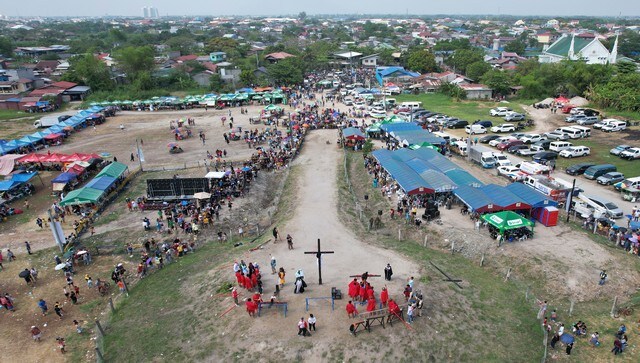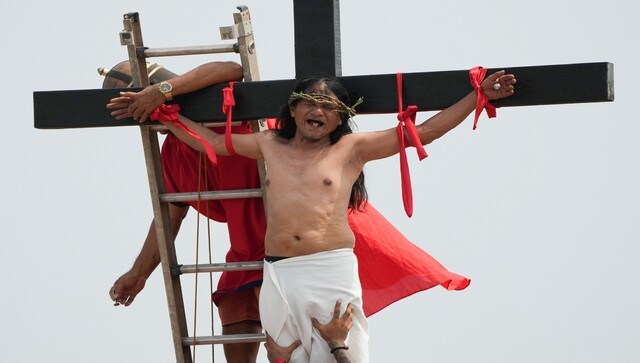On Good Friday, Filipinos get nailed to crosses
Branded as ‘gory’ by some onlookers, the tradition of real-life crucifixion in San Pedro Cutud involves penitents walking barefoot carrying their own wooden crosses on their backs for more than a kilometre

Ruben Enaje, center, stays on the cross beside two other devotees during a reenactment of Jesus Christ's sufferings as part of Good Friday rituals April 7, 2023 in the village of San Pedro, Cutud. AP
San Pedro Cutud: Good Friday, a day to mourn the death of Jesus Christ, is celebrated a little too seriously in the Philippines where at least 12 Filipinos will be nailed to crosses to re-enact the sufferings of God.
The practice has been long rejected by the Catholic church. However, owing to its popularity which draws crowds of devotees and tourists in the country, the tradition has been allowed to carry out.
This year’s real-life crucifixions in the village of San Pedro Cutud in Pampanga province north of Manila will be held after a three-year hiatus due to COVID.

Organisers this year expect a footfall of about 20,000 foreign and Filipino tourists and devotees.
Johnson Gareth, a British tour organiser, said, “They like this because there is really nothing like this on earth.”
He added, “It’s less gruesome than people think. They think it’s going to be very macabre or very disgusting but it’s not. It’s done in a very respectful way.”
About the tradition
Branded as “gory” by some onlookers, the tradition of real-life crucifixion in San Pedro Cutud involves penitents walking barefoot carrying their own wooden crosses on their backs for more than a kilometre.
Those who participate must wear thorny crowns of twigs. After reaching the location, villagers crossed dressed as Roman centurions would hammer 4-inch of stainless-steel nails into their palms and feet. The devotees are then lifted on a cross under the sun.
Apart from the practice of self-crucifixion, other penitents walk barefoot through village streets and beat their bare backs with sharp bamboo sticks and pieces of wood.
Most of the participants belong to the impoverished community of the Philippines who voluntarily undergo the ritual to atone for sins, pray for the sick or for a better life, and give thanks for miracles.
The story of Ruben Enaje
Ruben Enaje, a 62-year-old sign painter, has been a veteran of the real-life crucifixion tradition.

This year, Enaje, who will be nailed to the wooden cross for the 34th time, wishes to pray for the eradication of the COVID pandemic from the world and the end of the Russia-Ukraine war.
In 2018, Enaje said he no longer feels any pain from his wounds.
“In the past, I went home injured and limping, but this year I feel so great,” he said at the time.
Referring to a message from Jesus Christ, he said, “I feel like he is telling me ‘go ahead, keep it up’.”
Why does the church oppose to the tradition?
The practice of real crucifixion and self-beatings hasn’t been well-received by many, even the catholic church.
Dating back to the 1950s, the tradition is based on a play written about Jesus by a local playwriter that led to the first crucifixion in 1962.
Catholic priests in the Philippines condemn the practice and health officials have also flagged concerns about the crucifixions.
Testaments from devotees show that the wounds from the nailing take up to two weeks to heal.
Robert Reyes, a prominent Catholic priest and human rights activist said, “The question is where were we church people when they started doing this? If we judge them, we’ll just alienate them.”
Read all the Latest News, Trending News, Cricket News, Bollywood News,
India News and Entertainment News here. Follow us on Facebook, Twitter and Instagram.
also read

China warns Philippine-US base deal 'endangering regional peace'
China warned on Tuesday that Washington was "endangering regional peace" in a new deal with the Philippines that will see four additional bases be used by US troops, including one near the disputed South China Sea and another not far from Taiwan

31 killed after fire rips through Philippine ferry
At least 31 people died and 230 were rescued after a fire engulfed a ferry in the southern Philippines, authorities said Thursday.

Philippines, China to use diplomacy to address boundary disputes
The Philippines hosted this week the first in-person meeting between diplomats from the countries since before the pandemic, amid a flare-up in tensions over what Manila described as China's "aggressive activities" in the South China Sea
